Supreme Strength is the Benchmark, Intelligent
Lightweight Construction is the Principle.
• Mean body stiffness up 55 per cent.
• Appropriate use of high-strength and ultra-high-strength steel;
doors, engine lid and spring supports made of aluminium.
• Active engine lid for optimum pedestrian safety.
The exterior design of the new BMW 5 Series Sedan offers a
perfect balance of aesthetic looks and sporting dynamics. The body
structure, in turn, sets new standards in terms of solidity and
intelligent lightweight construction, use of the most appropriate
materials serving to meet the greatest demands in passive safety
and at the same time optimise the weight of the car in the
interest of enhanced efficiency and driving dynamics.
A wide range of safety components interacting precisely with one
another in a carefully coordinated overall concept guarantees
excellent occupant safety whenever a collision is unavoidable. The
safety concept of the new BMW 5 Series Sedan also incorporates
fundamental structural and innovative technologies for optimising
pedestrian safety on the road, thus adding reliable protection in
all conceivable crash situations to the Sheer Driving Pleasure so
characteristic of a BMW.
Hence, the new BMW 5 Series naturally meets all requirements for
achieving excellent results in all crash tests the world over. The
new BMW 5 Series Sedan comes with an extremely stiff
passenger
cell, intelligent use of high-strength multi-phase steel and
hot-moulded ultra-high-strength steel giving the safety passenger
cell maximum stiffness on relatively low weight. Compared with the
former model, mean stiffness of the body structure is up by
approximately 55 per cent in the interest of optimum passive safety
and as the foundation for excellent driving dynamics.
The lightweight quality rating, that is torsional stiffness as a
function of the car’s footprint and overall weight, is also
absolutely outstanding.
Aluminium doors reducing the weight of the car by 23
kg or 51 lb.
Apart from the engine lid, the front side panels and the front
spring supports on the body, the doors of the new BMW 5 Series
Sedan are also made of aluminium. Indeed, the use of aluminium
doors alone instead of conventional steel components serves to
reduce the overall weight of the car by approximately 23 kg.
With its particular moulding requirements, aluminium demands a
far more sophisticated production process than, say, steel. A new
structural concept developed by BMW nevertheless allows the use of
aluminium in the proven shell plate structure, maintaining the
design features typical of BMW also when using this extra-light
material.
Longest wheelbase in the segment for perfect
proportions, harmonious axle load distribution, generous interior
space and maximum occupant safety.
Wheelbase of the new BMW 5 Series Sedan measures 2,968
millimetres or 116.9″, thus setting a new record in the upper
midrange segment. This sets the starting point for the ideal
proportions of the car crucial to both its looks as well as its
driving characteristics and the high standard of occupant safety
provided by the new BMW 5 Series Sedan. Short overhangs and a
longer front section than on the former model, with the engine
fitted further behind the front axle, provide weight distribution
close to the ideal of 50:50 on all variants of the new BMW 5 Series
Sedan.
At the same time the proportions offer optimum conditions for
implementing the demanding safety concept with maximum occupant
safety as well as innovative features serving to protect
pedestrians in the event of a collision. The seating position has
been further optimised over the former model both front and rear,
with kneeroom on the rear seats of the new BMW 5 Series Sedan up by
13 millimetres or 0.5″. Luggage compartment capacity is 520 litres
or 18.2 cubic feet, and the folding rear-seat backrest available as
an option provides greater flexibility in enlarging the car’s
transport capacities. In addition to its 40:60 split, the rear-seat
backrest also comes with throughloading and, as yet a further
option, a ski-bag for additional convenience.
Contoured sliding roof: more light and harmonious
design.
The contoured sliding roof allows a precise flow of fresh air
into the car and bright light within the passenger compartment
emphasising the sheer generosity of the ambience inside the car.
The contoured sliding roof has been further optimised on the new 5
Series Sedan in terms of both size and function compared with a
conventional glass roof, the glass panel now measuring 60 cm/23.6″
in length and 92 cm/36.2″ in width, with an opening of 39
cm/15.4″.
A further highlight is the harmonious integration of the glass
panel in the outer skin of the car ensured by the contoured sweep
at the front end of the glass panel following the front edge of the
roof.
Precise mechanical alignment ensures a highly accurate connection
of the front edge of the glass roof and the seal on the sliding
roof also when the roof is in vent position, preventing any
unpleasant noise caused by air swirl.
The contoured sliding roof is moved to and fro by two electric
drive motors, the control unit is integrated in the roof lining
together with the buttons for the car’s interior lights. The
sliding roof liner integrated harmoniously into the interior of the
car, finally, also moves to and fro electrically.
Superior occupant safety on all
seats.
High-load-resistant bearing structures, generous and exactly
defined deformation zones as well as highly efficient restraint
systems coordinated by the car’s high-performance electronic
control units set the foundation for a high standard of passive
safety in the new BMW 5 Series Sedan. Forces generated in a head-on
collision are diverted by several load paths in the floorpan, on
the side frame, in the bulkhead and in the roof, absorbed by the
deformation zones and thus kept away from the passenger cell.
The load-bearing structures forming the load paths are made
largely of multiphase steel and hot-moulded steel, an additional
bumper system around the front axle serving to spread out the
forces acting on the front section of the car.
Reinforced side structures in the B-pillars and the side-sills,
extra-strong door reinforcements and stable crossbars on the seats
limit the depth of deformation as well as the speed of intrusion in
the event of a collision from the side. With its reinforced pillars
and roof supports, the passenger cell also offers safe survival
space for the occupants in the event of a rollover.
Within the new BMW 5 Series Sedan the frontal and hip thorax
airbags are supplemented by curtain head airbags at the side for
both rows of seats as a standard feature. Depending on the type and
severity of a collision, the integrated safety electronics
determine the restraint effect provided and the time of release. In
accordance with national requirements, finally, the frontal airbags
come with a single or two-stage gas generator.
All seats feature three-point inertia-reel seat belts and belt
force limiters, with an additional belt latch tightening function
on the front seats. To prevent cervical spine injury in the event
of a collision from behind, the front seats come as standard with
crash-activated headrests. Masterminded by the car’s safety
electronics, these headrests move up instantaneously in the event
of a collision, closing the gap between the front end of the
headrest and the occupant’s head by up to 60 cm or 24″
front-to-rear and up to 40 cm/16″ in a vertical direction.
The occupant’s head is therefore very close to the headrest even
before being moved back by the forces acting on the car. This
enhances the stabilising and protective function of the headrests
and reduces the risk of injury or hyperextension around the
occupant’s cervical spine. Both ISOFIX child seat fastenings at the
rear and the option to deactivate the front passenger’s airbag
naturally come as standard.
The safety steering column on the new BMW 5 Series, in turn,
comes with a load-related deformation element as well as an
extra-large spacer unit protecting the driver additionally from
collision forces coming out of the engine compartment.
Active engine lid for optimum pedestrian
safety.
To optimise the high standard of passive pedestrian safety, the
new BMW 5 Series Sedan comes, depending on national specifications,
with an active engine compartment lid automatically moving up in a
collision with a pedestrian. The pyrotechnical release mechanism is
activated at speeds between 20 and 55 km/h (12 – 34 mph) as soon as
data acquired by sensors at the front of the car indicate a
collision with a pedestrian, lifting up the engine lid 30 mm/1.18″
at the front and 50 mm/1.97″ at the rear.
This provides additional deformation travel beneath the engine
lid, such absorption of impact energy serving to reduce the risk of
injury or at least the consequences of an accident.
Optimum visibility: bi-xenon headlights, LED daytime
driving lights and Adaptive Headlights with variable light
distribution.
The dual round headlights on the new BMW 5 Series Sedan so
typical of the brand ensure excellent illumination of the road in
the dark and in the case of poor visibility on account of bad
weather. On the standard headlights, LED light rings serve as
positioning lights, again in typical BMW style, forming a clear and
consistent light circle.
Further standard features are the foglamps and the light sensor
automatically activating the low beam as a function of ambient
brightness. A rain sensor determining the intensity of
precipitation and thus allowing automatic adjustment of the
screenwipers is likewise fitted as standard. The new BMW 5 Series
Sedan is available as an option with bi-xenon headlights in which
case the LED units in the characteristic light rings may be
operated in two stages.
Dimmed to approximately 10 per cent of their full power, they
serve as positioning lights. Switched to 100 per cent, in turn,
they provide a daytime light function in typical BMW style. The
rear lights on the new BMW 5 Series Sedan generate their strong
effect and clear visibility through three-dimensional,
homogeneously glowing light bodies. The taillights, brake lights
and direction indicator come in LED technology.
To avoid collisions from behind, the new BMW 5 Series Sedan,
like other models from BMW, features a special warning system for
motorists following the car. This is a further development of the
Adaptive Brake Lights introduced by BMW as the world’s first
manufacturer to offer such a feature. When applying the brakes
particularly hard and when ABS is activated, drivers following from
behind are immediately alerted by the brake lights conspicuously
flashing on and off, prompting them to brake equally hard.
And after the car has come to a standstill following
particularly powerful application of the brakes, the hazard warning
flashers are automatically activated.
NU UITA, pe 24 nov. îţi oferim PRIMELE
IMPRESII LIVE CU NOUL BMW SERIA 5!
Noul BMW Seria 5, care
poartă numele de cod intern F10, reprezintă un model foarte
important pentru BMW, având în spate
o istorie de aproape 40 de ani şi
ajungând deja la a 6-a generaţie.
VEZI VIDEO ŞI POZE CU NOUL
BMW SERIA 5!
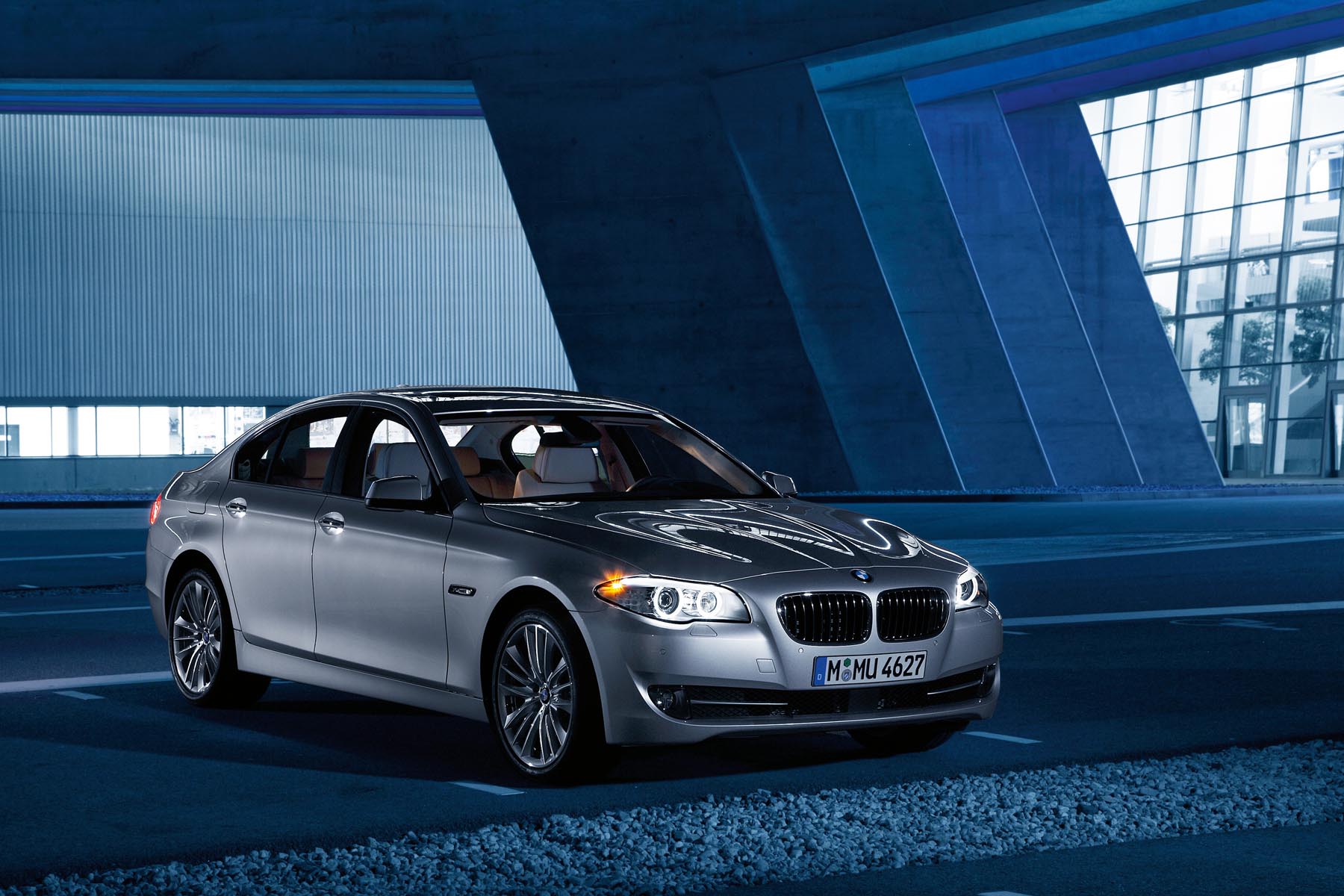 Stilistic
Stilistic
vorbind, designul noului BMW Seria 5 F10 este unul destul
de sobru, dar cu tuşe foarte sportive. BMW revine la o
idee aplicată în cazul altor generaţii, în care Seria 5 este un
melanj estetic între limuzina
BMW Seria 7 şi berlina de clasă medie BMW Seria 3 – în cazul
lui F10, acest lucru înseamnă că maşina îmbină nobleţea şi
impozanţa caracteristice limuzinei mai mari cu agilitatea şi
dinamismul fratelui mai mic.
Iar rezultatul este unul foarte echilibrat, dar nu în întregime
nou – asta deoarece, în mare, liniile de design ale noului
BMW Seria 5 au fost deja arătate de versiunea inedită
BMW Seria 5 GT, lansată înaintea berlinei.
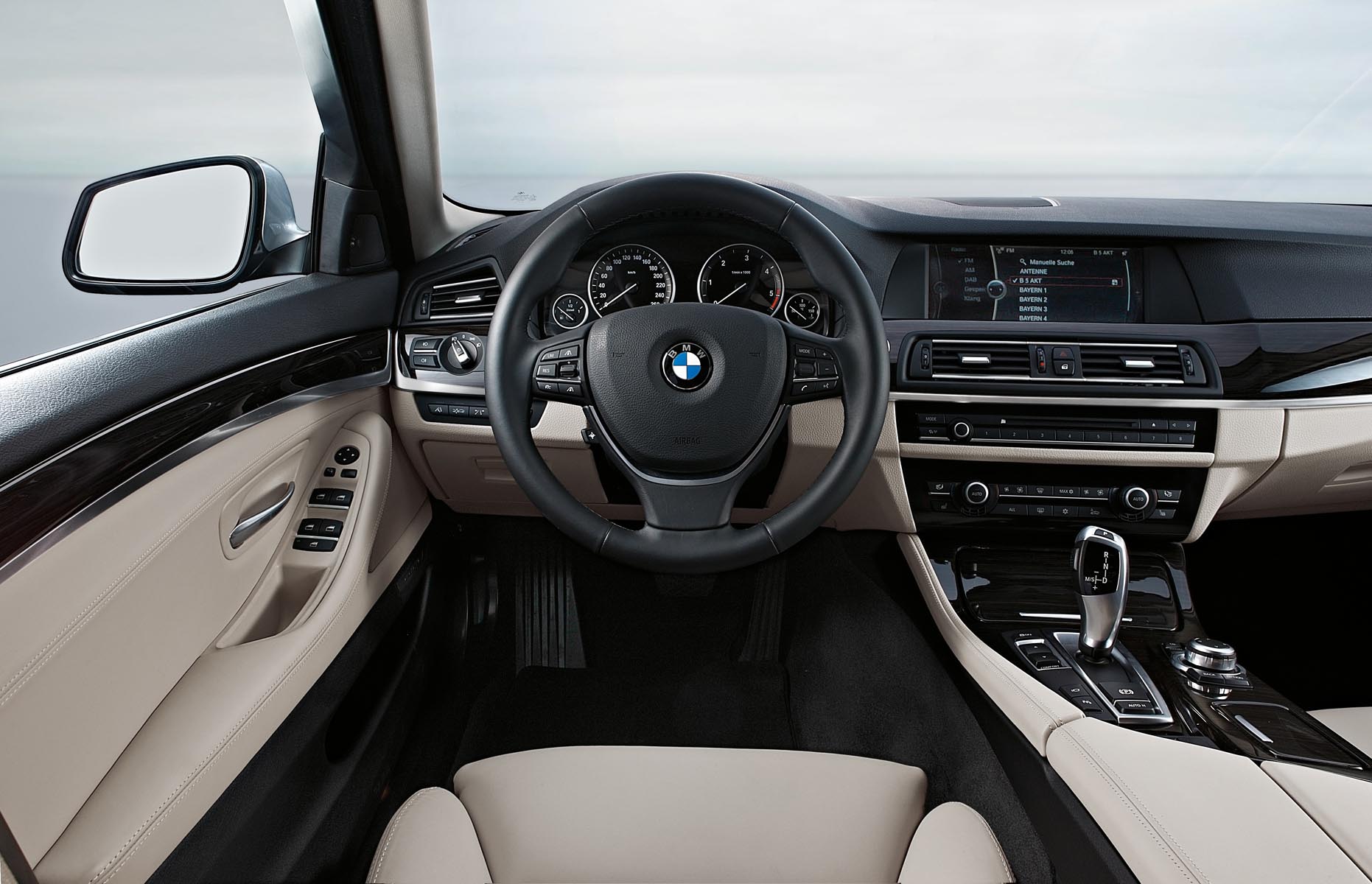 Aşadar,
Aşadar,
faţă de
Seria 5 E60, generaţia pe care o înlocuieşte, noul Seria 5 nu
mai mizează pe un design exterior revoluţionar. Lucru continuat şi
la interior, unde găsim un aer familiar deja, provenind
atât de la Seria 5 GT, cât şi de la Seria 7. Accentul este
pus pe spaţiu (ampatamentul măsoară aproape 3 metri), confort, lux
şi ergonomie.
Cockpitul este, din nou, orientat mai mult către şofer şi
beneficiază de tehnologia Black Panel, iar funcţiile ţinând de
conducere sunt separate de cele ţinând de confort.
Bineînţeles, nu lipseşte cea mai nouă evoluţie a sistemului
iDrive , care afişează informaţiile pe un display de 7 inch (sau,
opţional, pe unul de 10″) toate informaţiile necesare.
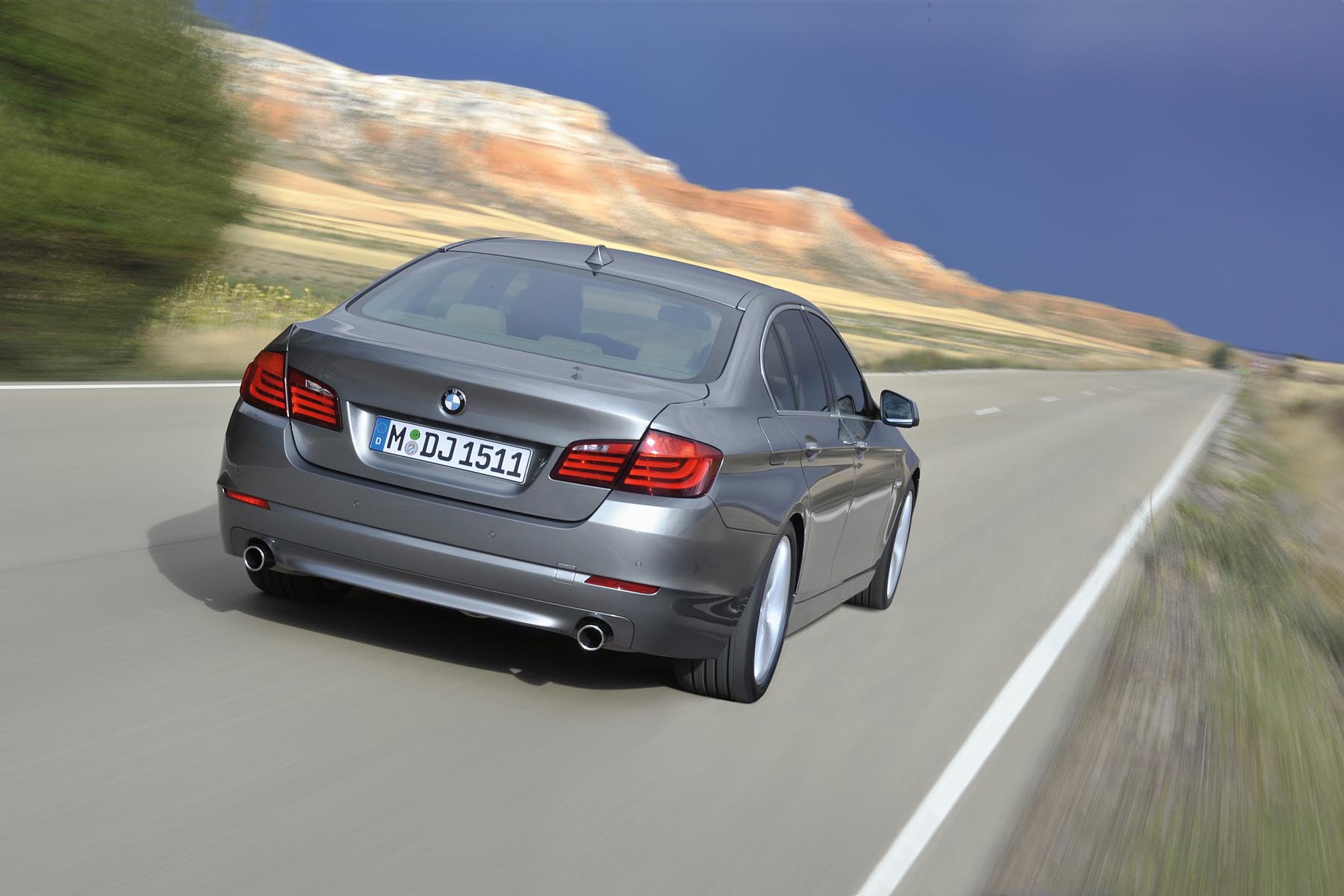 Dintre
Dintre
inovaţiile marcante amintim sistemul BMW ConnectedDrive,
care înglobează o serie de sisteme de asistenţă: Parking
Assistant, Surround View (senzori de perimetru), Collision Warning
(sistem de prevenire a coliziunilor – pregăteşte toate sistemel de
siguranţă pentru oprirea de urgenţă), Active Cruiser Control (pilot
automat cu ajustarea automată a vitezei în funcţie de maşinile din
faţă), sistem Stop&Go pentru motor, BMW Night Vision şi
altele.
Noul BMW Seria 5 este construit pe o platformă tehnică
având multe elemente comune cu limuzina BMW Seria 7. Acest
lucru asigură maşinii un comportament rutier la cel mai înalt
nivel, iar tehnologiile de care beneficiază asigură şoferului
plăcerea de a conduce, peste ceea ce oferă concurenţa.
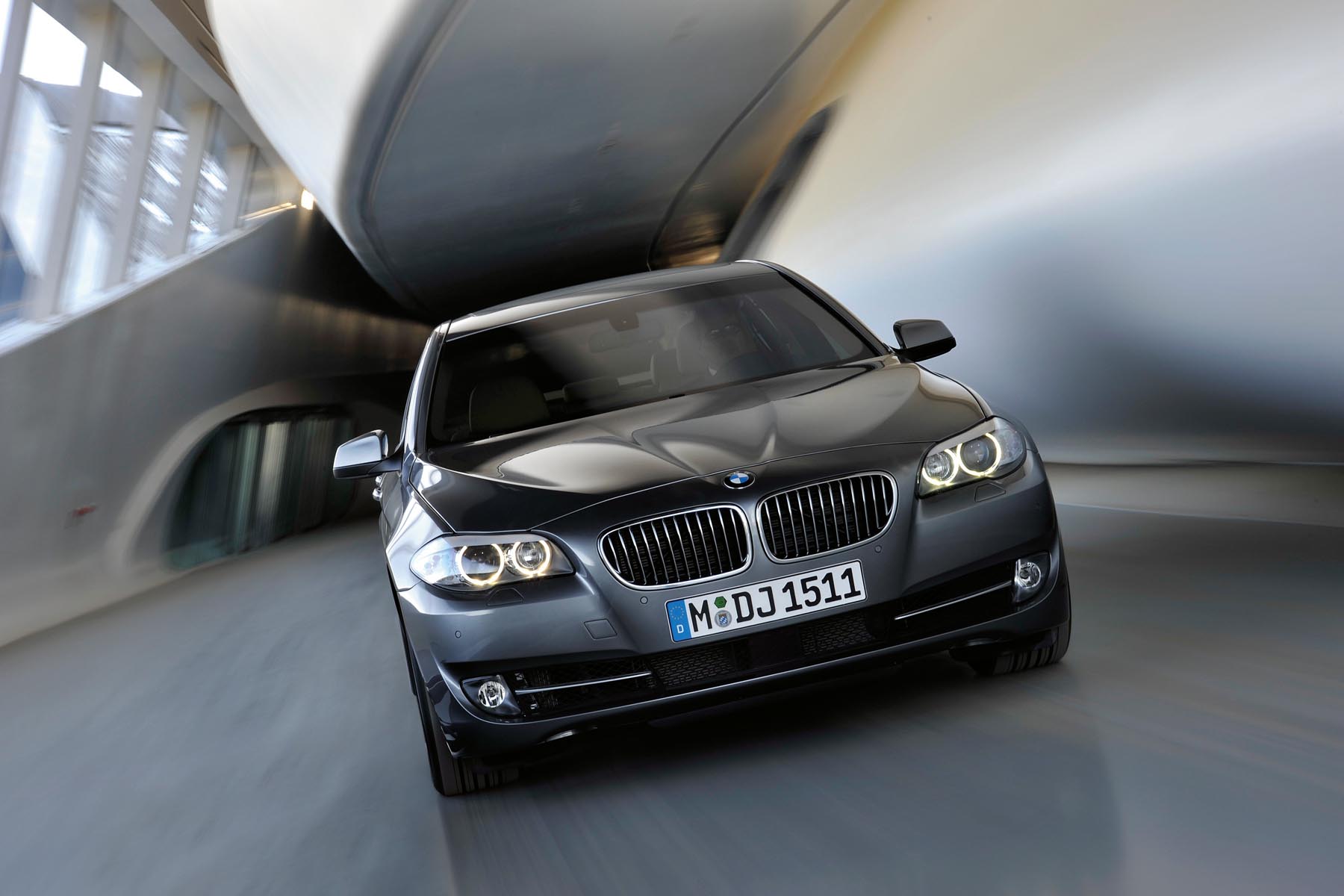 Rigiditatea
Rigiditatea
faţă de precedenta generaţie este crescută cu 55%, în timp ce
eficienţa proiectării a dus la mase proprii mai mici decât ale
versiunilor generaţiei precedente.
Compromisul între sportivitate şi confort se datorează, în
primul rând, suspensiei şi sistemelor electronice de asistenţă
activă. Opţional, noul BMW Seria 5 oferă sistemul Dynamic
Driving Control, prin care modul de funcţionare al
suspensiei poate fi modificat de către cel de la volan, conform
cerinţelor personale.
Nu lipsesc din listă sistemele Adaptive Drive (constând din
Dynamic Dumper Control – controlul dinamic al amortizării – şi din
Dynamic Drive Stability Control – controlul dinamic al
stabilităţii), precum şi Integral Active Steering (servodirecţia
electrohidraulică activă).
La capitolul motorizări, noul BMW Seria 5 oferă, pentru
început, o gamă de 7 motorizări: patru pe benzină şi trei
dieseluri.
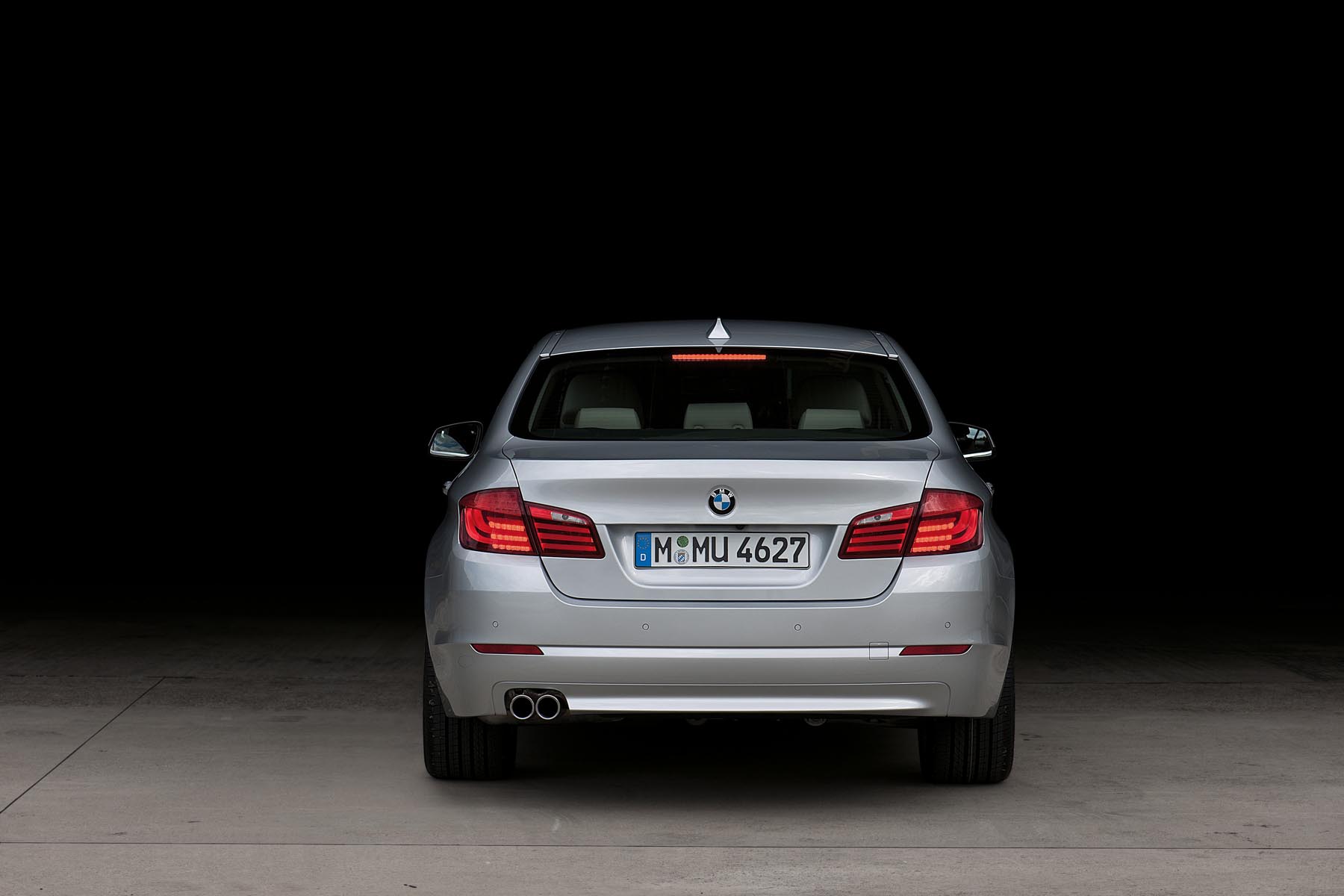 Cel
Cel
mai puternic este 550i, care beneficiază de un V8 cu tehnologie
twin-turbo, capabil de 407 CP şi cuplat la o cutie de viteze
automată cu 8 trepte, optimizată pentru eficienţă. Celelalte trei
motoare pe benzină au şase cilindri în linie: 523i (204 CP), 528i
(258 CP) şi 535i cu tehnologie bi-turbo (306 CP).
Toate motoarele pe benzină sunt compatibile cu normele
de poluare Euro 5 şi beneficiază de tehnologia High
Precision Injection, ceea ce înseamnă un randament mult mai bun al
arderii (de exemplu, consumul mediu al motorului V8 este de numai
10,4 litri/100 km).
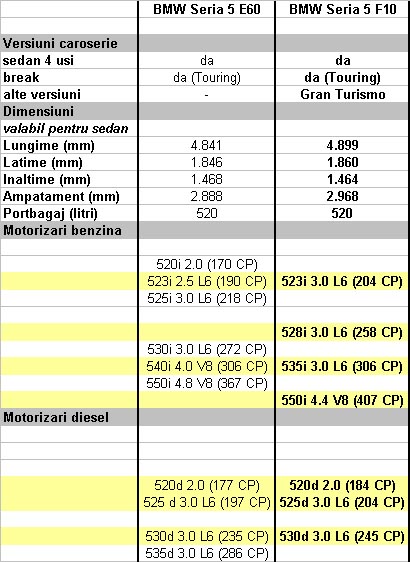 Cel
Cel
mai mic motor diesel este cel de pe 520d, având 4 cilindri şi
dezvoltând 184 CP. Acest propulsor este echipat cu sistemul
Start&Stop, iar consumul mediu este creditat cu 5,0
litri/100 km, în timp ce emisiile CO2 sunt de numai 132
g/km, o valoare foarte mică pentru acest segment.
Celelalte două motoare diesel au câte 6 cilindri în linie: 525d
dezvoltă 204 CP, iar 530d are 245 CP, fiind dotat opţional cu
tehnologia BMW BluePerformance, 530d devenind astfel compatibil cu
normele antipoluare Euro 6.
Toate versiunile noului BMW Seria 5 beneficiază de
tehnologiile BMW EfficientDynamics, dintre care amintim
recuperarea energiei la frânare, indicator pentru schimbarea
treptelor de viteză (la cutiile manuale), controlul activ al
flapsurilor aerodinamice sau Electric Power Steering (servodirecţi
asistată electric, având un consum mic de energie).
Pentru o masă cât mai scăzută, portierele, capotele motorului şi
portbagajului, aripile faţă şi componentele suspensiei sunt
realizate din aluminiu.
Vezi aici toate
datele tehnice pentru noul BMW Seria 5 F
10:
–
dimensiuni exterioare şi interioare
În România, noul BMW Seria 5 va fi lansat la începutul
anului 2010, preţurile şi echipările urmând a fi
comunicate în preajma lansării naţionale.
NU UITA, pe 24 nov. îţi oferim
PRIMELE IMPRESII LIVE CU
NOUL BMW SERIA 5!
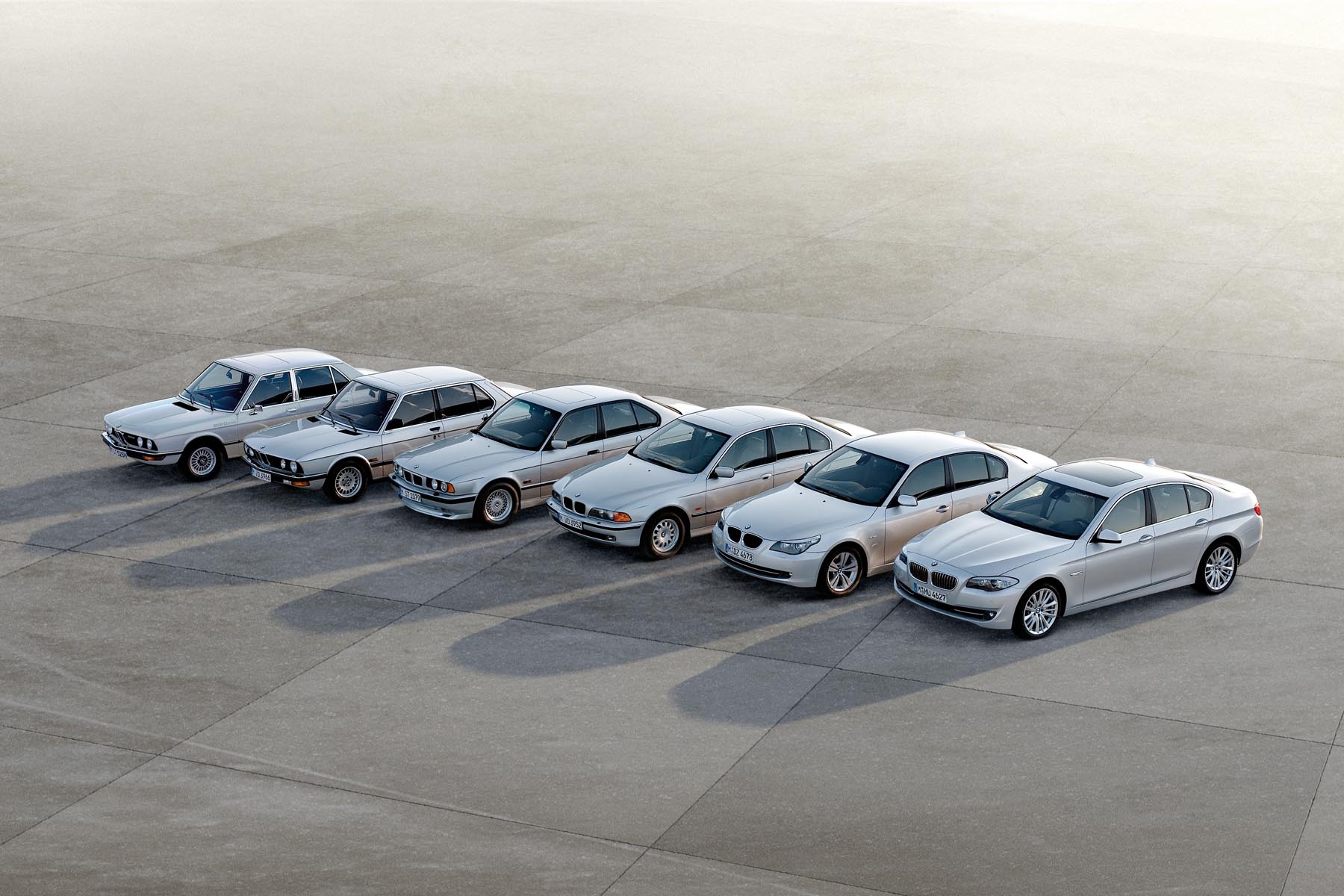
Vezi pe
paginile următoare toate detaliile despre noul BMW Seria 5, în
comunicatul oficial BMW.